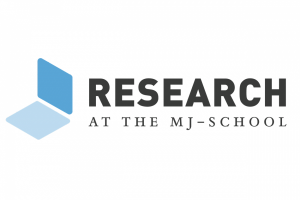Research Publication Roundup: March 2019

A vibrant and collaborative interdisciplinary research culture at the UNC Hussman School of Journalism and Media creates new knowledge, advances scholarship and helps reinvent media. Below is a list of recently published or presented scholarship by Hussman School faculty and students.
RECENT PUBLICATIONS
This study explores the impact of the “fit” of corporate social responsibility (CSR) initiatives in industries stigmatized by society, or industries whose products or production processes have a negative societal impact. An experiment involving a fictitious cola company and its promotion of anti-obesity versus literacy CSR activities was used to examine the effect of fit with negative contribution on skepticism, attitudes toward the company and the CSR initiative, and participants’ stated supportive intentions toward the company. In partial support of the hypotheses, findings revealed that, for the high-fit negative contribution CSR initiative (anti-obesity), skepticism was heightened while both attitudes toward the company and supportive intentions toward the company’s products were negatively impacted, in comparison with the low-fit CSR initiative (literacy). While attitudes about the social initiatives of anti-obesity versus literacy were not significantly different, findings also suggest participants felt obesity was a more important cause for the cola company to undertake. The practical and ethical implications for CSR are discussed.
In line with calls for action from international health organizations, Chile implemented in June 2016 a set of regulations to tackle the obesity epidemic. The new regulation includes the mandatory use of front-of-package warning labels on packaged foods/beverages high in energy, sugars, saturated fats and sodium. Additionally, such foods cannot be sold nor offered in daycares/schools and cannot be promoted to children under 14yo. The law is targeted to children; thus, this study examined mothers’ understanding, perceptions, and behaviors associated with the regulation one year after its implementation, using a qualitative approach. Nine focus groups of mothers of children (2-14yo) were conducted in July 2017 in Santiago-Chile. After the first year of implementation, the regulation was well known by mothers of diverse SES and different children ages. The degree of use of warning labels was heterogeneous among participants, but most of them agreed that their children, particularly the youngest have positive attitudes toward the regulation and have become promoters of change in their families. Many mothers also expressed that they perceived an important shift toward healthier eating, which may lead to a change in eating social norms. This information contributes to better understand how regulatory actions may influence people’s consumer behaviors.
This quantitative content analysis uses 36 years of New York Times international news to understand how conflict coverage is presented to audiences in terms of quantity and geographic focus, whether conflict is covered because of its linkage to US interests, and whether the Times relies on its own personnel for first-hand coverage. Additionally, a contemporary history approach gauges how representative coverage is of conflicts in varying regions. Quantitative data reveal an imbalance in coverage; stories about low-income nations focused more on conflict and were more likely to link events to US interests. However, the volume of coverage of these countries was minimal and arguably failed to report some of the most severe internal crises in those nations. According to social construction of reality theorists, this imbalance and distortion can lead to audience perception that more conflict occurs in low-income nations than in other, more developed parts of the world.
As cigarette use rates decline among adolescents and young adults, public health officials face new challenges with high use of non-cigarette tobacco products (NCTPs). Online tobacco education is a potential solution to discourage use, yet limited information is available for how online media should look and function. This study aims to fill this gap by conducting focus group interviews to identify adolescents and young adults’ aesthetic and functionality preferences for online tobacco education (phase 1) followed by interviews to assess a NCTP education website developed (phase 2). Researchers found preferences for use of font and colors to highlight tobacco information in organized designs. Interactive features (quizzes) motivated engagement, and participants desired responsive designs that function similarly across devices. Public health researchers and educators should apply aesthetic and functionality preferences to reduce NCTP use and help create a tobacco-free future for youth.
This study examines reactions to “The Real Cost” advertisements among a potential secondary audience: U.S. young adults. An online convenience sample of young adult (ages 18–29 years) smokers (n=225) and susceptible nonsmokers (n=339) participated in a within-subjects experiment in 2017. Participants viewed three TV ads from “The Real Cost” campaign and reported their past exposure to, conversations about, and reactions to the ads. In 2017, analyses examined message-level and person-level predictors of perceived message effectiveness using multilevel modeling. Susceptible nonsmokers rated the ads higher on perceived message effectiveness than smokers, but lower on message relevance and negative affective reactions to the ads. In both samples, ads that elicited higher negative affective reactions and message relevance, and lower message reactance (i.e., resistance) received higher perceived message effectiveness ratings. Increasing the perceived relevance and emotional reactions of campaigns may increase their impact.
Men who have sex with men (MSM) disclose same-sex behaviors with others, creating disclosure networks. This study examined the characteristics of disclosure networks that are associated with HIV testing among MSM in China through an online nationwide survey. Name-generator questions were used to ask each participant ("ego") to nominate up to five social network members ("alters") with whom he had disclosed same-sex behaviors. Among the 806 men, the average disclosure network size was 4.05. MSM who reported larger disclosure networks were more likely to have been tested for HIV. The most common disclosure network alters were friends (45.1%), followed by sex partners (18.7%) and healthcare professionals (2.5%). Men who disclosed to healthcare professionals were more likely to test for HIV compared to men who disclosed to family members. The researchers’ findings can inform disclosure network-based interventions to promote MSM HIV testing.